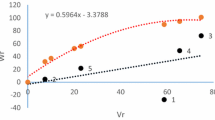Abstract
A complete diallel cross study of ten pearl millet inbred parents was used to estimate g.c.a. and s.c.a. for grain yield and eight other related characters (length and diameter of peduncle, surface area of primary ear, density of grain, yield of primary ear, plant height, tillering capacity and yield of straw). General combining ability effects were of a lesser order than those of s.c.a. for most of the characters studied. Highly significant s.c.a. effects for many characters point to the immense practical value of utilising the same in the exploitation of heterosis. Lines with superior g.c.a. and hybrids manifesting outstanding s.c.a. in respect of each character could be marked out.
Similar content being viewed by others
References
Griffing, B... “Concept of general and specific combining ability in relation to diallel crossing systems,”Austr. J. biol. Sci., 1956,9, 463–93.
Mahadevappa, M... “Studies on heterosis in pearl millet (Pennisetum typhoides Stapf and Hubb.). I. Expression of hybrid vigour and reciprocal effects,”Proc. Ind. Acad. Sci., 1968,67 B, 180–86.
Author information
Authors and Affiliations
Additional information
Communicated by Prof. T. S. Sadasivan,f.a.sc.
A part of the Ph.D. Thesis, University of Madras, India (October, 1965). Work done at the Agricultural College and Research Institute, Coimbatore, India.
Rights and permissions
About this article
Cite this article
Mahadevappa, M. Studies on heterosis in pearl millet (Pennisetum typhoides stapf and Hubb.). Proc. Indian Acad. Sci. 67, 187–194 (1968). https://doi.org/10.1007/BF03053871
Received:
Issue Date:
DOI: https://doi.org/10.1007/BF03053871



